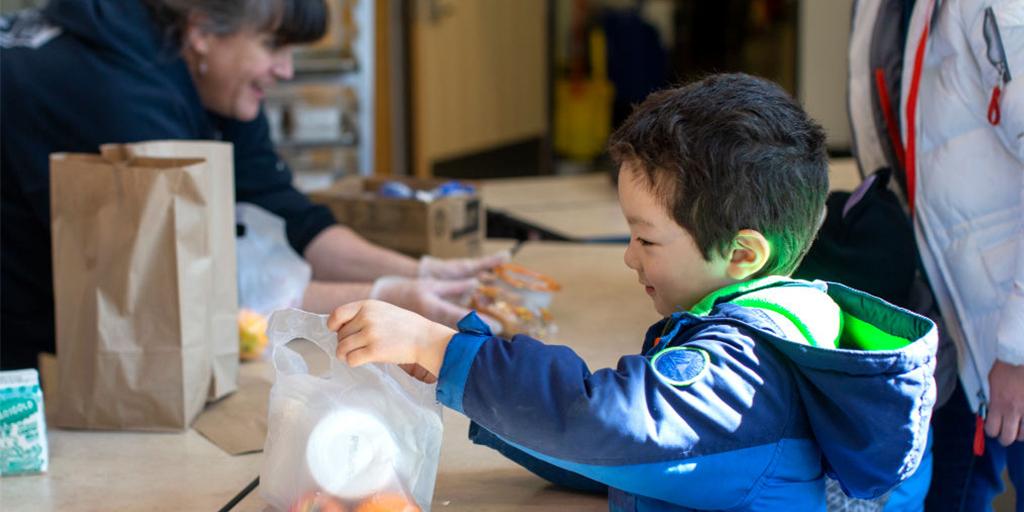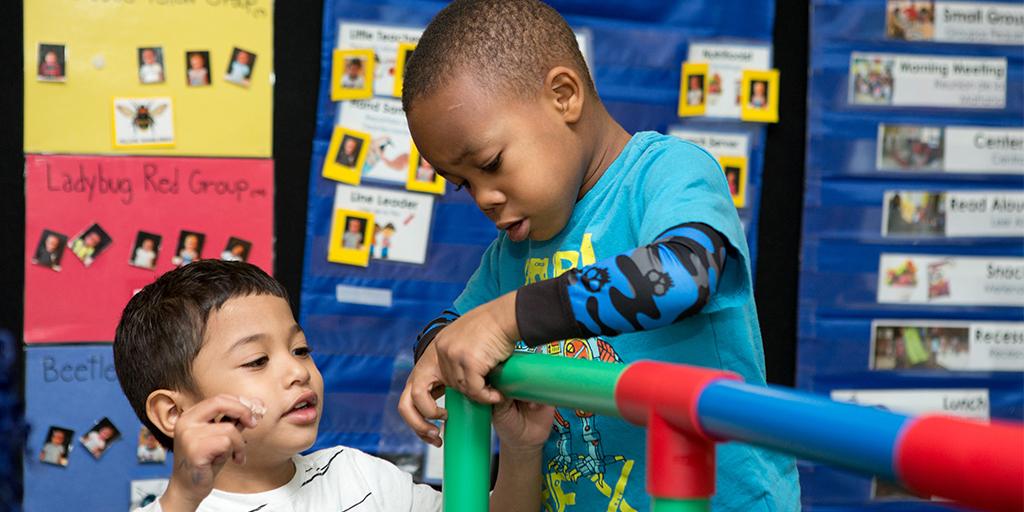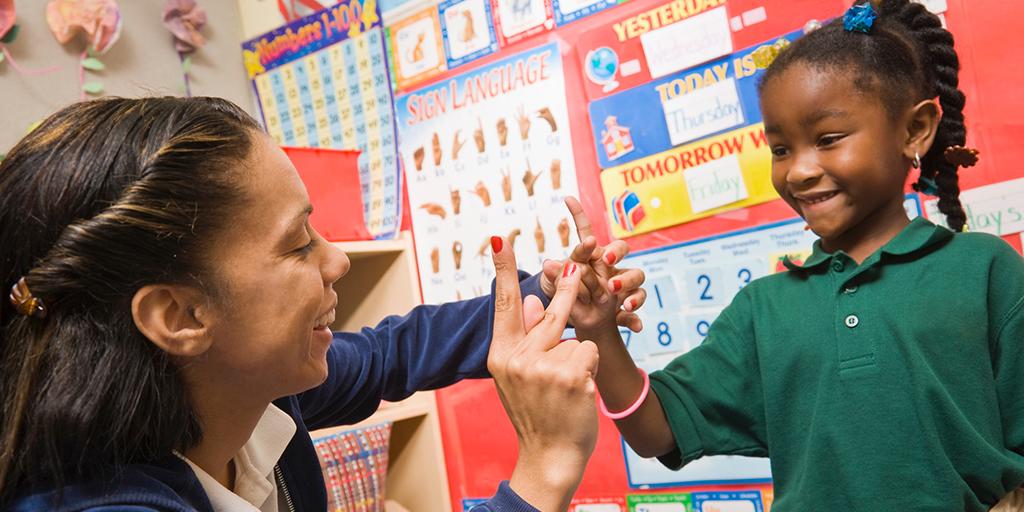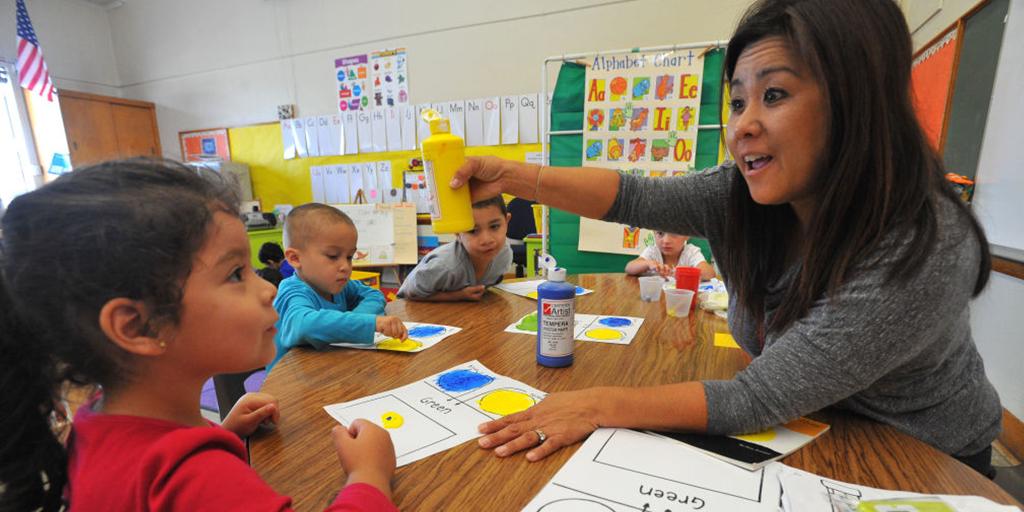Pre-K Data on Children, Families, and Workforce Members from Focal Populations Can Help Decision Makers Create More Equitable Systems
Updated May 16, 2023: This product has been updated to reflect that the Pre-K Data Equity Framework has been renamed the System Transformation for Equitable Preschools (STEP Forward with Data) Framework.
All children and families are deserving of high-quality pre-K services and systems that help children thrive, value who they are, and offer positive and equitable environments. Comprehensive data on families’ access to, experiences with, and outcomes in pre-K can help system leaders[1] promote more equitable systems to support all pre-K children and families, as well as the system’s workforce members. An equitable system[2] reflects a set of connected policies, programs, services, and infrastructures created in partnership with communities to reflect the strengths, needs, values, languages, and cultures of participating children, families, and workforce members. We conceive of equity as both an outcome and a process that is achieved through intentional and informed action. Within the pre-K system,[3] equitable outcomes happen when children and families’ access to, experiences within, and impacts from pre-K do not vary based on their identities. Equitable processes are those whereby programmatic pre-K policies and practices are both shaped to support equitable outcomes and are shaped by those most impacted by inequities.
Systemic inequities persist within the pre-K system—as they do in many U.S. institutions—despite policy efforts to expand the supply of pre-K, invest in quality improvement initiatives, and prioritize enrollment for those who have been marginalized. This category includes, but is not limited to, children, families, and workforce members from Black, Hispanic/Latino, or Indigenous backgrounds; those experiencing poverty; those with disabilities or developmental delays; those who are immigrants; and those who are multilingual learners. This brief aims to describe the experiences of these specific groups of children, families, and workforce members[4] (referred to as focal populations) that face inequities and discuss how a comprehensive pre-K data system can bolster ongoing efforts to ensure that all children experience the benefits of pre-K and that all families and workforce members are supported. These focal populations will be central to the development of a forthcoming System Transformation for Equitable Preschools (STEP Forward with Data) Framework through Child Trends’ Early Childhood Data Collaborative.
In the following sections, we first review the elements of high-quality, equitable pre-K and describe how such systems establish a strong foundation for children’s successful development. Then, we review how the Framework can help promote pre-K environments in which all children, families, and workforce members can thrive when systems attend to both their diversity and their shared and unique needs, strengths, and identities. The next section focuses on the equity challenges and data needs of each of our focal populations. Finally, in recognition that people hold more than one identity, we describe how intersectional identities[5] across focal populations can present unique strengths and challenges.
High-quality, equitable pre-K systems are foundational to children’s success
The pre-K system has the potential to set children on a trajectory of well-being and achievement starting in their early years, and to build upon the interactions and experiences within their daily lives. High-quality pre-K programs—such as those with strong curricula, professional development and workforce support, and educational engagement—represent a key step toward strengthening children’s early and later learning and development. Additionally, high-quality pre-K programs play a critical role in supporting families and staff. Parents have greater capacity to work or pursue their education when their children are enrolled in pre-K programs. The pre-K workforce is better equipped to support families and children when they are well-compensated, offered high-quality training and professional development, and have their wellness needs met. To live up to the promise of providing all children with a strong foundation for lifelong learning and development, pre-K programs must reach into all communities and reflect the lived experiences of those they serve.
Despite pre-K’s potential, its history and the available research on its implementation show that discriminatory policies and practices have contributed to inequitable access to and disparate outcomes for children, families, and the pre-K workforce. Discrimination entails unfair treatment based on a person’s identity. Disparities—such as those found in pre-K discipline, where boys and children of color experience higher rates of expulsion—have led to the development of federal provisions and guidance to address discrimination within early childhood programs. Those who make decisions around policy and practice often do not reflect the diverse races and ethnicities, cultures, abilities, or socioeconomic statuses of those impacted by pre-K systems, thereby reinforcing inequitable processes and outcomes.
All children deserve high-quality pre-K experiences that set them on a path for success, and those facing systemic inequities deserve supports and resources that level their opportunities to thrive. Pre-K leaders are in a unique position to recognize and be responsive to the strengths and lived experiences of communities that are marginalized by supporting policies and practices that advance equity.
How a preschool data framework can promote greater equity
The goals of the STEP Forward with Data Framework will be to help pre-K leaders collect and use data to understand the nature of, and the contributors to, persistent pre-K system inequities; and to inform continuous improvement of policies and practices that encourage a more equitable system. In addition to providing a broad picture of children, families, and workforce members in a pre-K system, the Framework will be designed to help pre-K leaders develop a nuanced, in-depth understanding of focal populations who continually face barriers related to pre-K access, experiences, and outcomes.
Focal pre-K families and workforce members often experience bias and discrimination based on race and ethnicity, language, income, disability status, and/or immigration status. Research suggests that understanding and meeting the needs of these groups will advance fairness and address systemic injustice, which will, in turn, benefit all children, in addition to those in focal populations. For this reason, the Framework will prioritize data about children, families, and workforce members from Black, Hispanic/Latino, or Indigenous backgrounds; those experiencing poverty; those with disabilities or developmental delays; those who are immigrants; and those who are multilingual learners. Importantly, the Framework can be used to understand the compounded challenges faced by those who have intersecting identities, and to better appreciate the diversity within and across these groups since not all focal populations experience inequity in the same way. At the same time, the Framework can be adapted to understand and address the experiences of other populations that states and communities have identified as having inequitable experiences or unique needs. Pre-K leaders will be able to use the Framework to gather data and answer essential questions about all children, families, and workforce members, and to narrow in on focal groups’ specific needs and experiences—an action at the heart of building a more equitable, inclusive, and affirming pre-K system.
Below, we highlight the critical barriers that focal populations face in the pre-K system, all of which underscore the need to better understand these groups’ experiences and collect consistent, national data to comprehensively address inequities within the pre-K system.[6] Research continues to show that more effective, data-driven solutions are essential to ensure that every child and family can benefit from pre-K, and that every member of the pre-K workforce is supported.
Equity Challenges and Data Needs Related to Focal Populations

Families experiencing poverty

Black, Hispanic/Latino, and Indigenous families

Families of children with disabilities or developmental delays

Children in immigrant families

Families with multilingual learners

Pre-K workforce members
Focusing on intersectionality is central to improving equity
Data can support pre-K leaders in understanding the amplifying effect that intersectionality can have on inequities, as well as the value that children and families with intersectional identities bring to pre-K programs and communities.
Children, families, and pre-K workforce members have multiple identities and lived experiences that intersect in ways that are often supportive of children’s learning. These intersections can help children build cultural traditions, rich language development, and resilience in the face of challenges. Yet intersecting marginalized identities, such as racial and ethnic identity and income, are often associated with structural and historical inequalities that “operate together and exacerbate each other.” For example, Black (26.5%), Hispanic (20.9%), and Indigenous (20.6%) children experience the highest rates of poverty and their families are more likely to experience poverty over the course of their lifetimes and intergenerationally. Black and Hispanic families have greater likelihoods of co-occurring hardships like loss of income and greater health challenges. Research has shown that, even with overall declines in exclusionary discipline practices, Black children with disabilities are suspended at disproportionately higher rates than White and Hispanic children and children without disabilities. Without examining the intersection between race and disability status, researchers may not have discovered this alarming trend. Data are critical to understand the amplifying effect that intersectionality can have on inequities, as well as the tremendous value that children and families with multiple identities and lived experiences bring to pre-K programs and communities.
Summary
While pre-K programs collect a multitude of data, what data are collected and how they are collected may vary greatly. Therefore, as a field, we cannot fully understand the diverse needs and unique strengths of children, families, and the workforce—and cultivate the necessary conditions for them to thrive—without reliable data to drive progress toward a more equitable pre-K system. The STEP Forward with Data Framework will be designed to explicitly focus on equity by identifying essential questions and corresponding data that pre-K leaders can use to better understand and counteract institutional policies and systemic barriers that produce disparities—not just individual outcomes. Pre-K leaders will be able to use the Framework to understand the key data needed to answer questions about understanding and addressing inequities; advancing the pre-K system as a whole; and, ultimately, improving how all children, families, and workforce members experience the pre-K system. Comprehensive data about the programmatic aspects of pre-K—administration, supply, outreach, eligibility and enrollment, utilization, experiences, and transition to kindergarten—can be used to improve policies and practices that provide equitable opportunities for and ensure equitable treatment of focal populations. Policies and practices that advance equity include:
- Increasing enrollment in high-quality care among populations that have been marginalized (e.g., implement strategies to increase outreach, access, and enrollment and to promote quality improvements in classrooms and programs)
- Promoting positive and enriching pre-K experiences (e.g., eliminate bias in classroom interactions and disciplinary actions)
- Developing affirming policies and practices (e.g., adopt culturally inclusive policies, provide professional development to support implementation of policies, and hire multilingual staff and use multilingual materials)
Data play an important role in building systems that promote positive life experiences and trajectories for children, families, and workforce members who are Black, Hispanic/Latino, or Indigenous; those experiencing poverty; those with disabilities or developmental delays; those who are immigrants; and those who are multilingual learners. Ultimately, the Framework will highlight how pre-K leaders can use data to ensure and strengthen equitable access, experiences, and outcomes within the pre-K system.
To read more about the project, our timeline, and how to contact our team, please visit our project page.
Acknowledgments
Thank you to our colleagues who supported the development and review of this product, including Alison Sapp, Gabriella Guerra, Silvana Esposito-Hackett, Van-Kim Lin, Elizabeth Jordan, Dale Richards, and Carlise King, as well as consortium members and our Child Trends communications team.
Definitions
Suggested Citation
Thompson, J., Bredeson, M., & Boddicker-Young, P. (2022). Pre-K data on children, families, and workforce members from focal populations can help decision makers create more equitable systems. Child Trends. https://doi.org/10.56417/6271a6086a
Footnotes
[1] “Pre-K leaders” encompasses individuals who are in positions that are responsible for making decisions about how a pre-K program is funded, administered, or operated. This category includes, but is not limited to, pre-K administrators, curriculum specialists, program directors, and workforce specialists.
[2] Adapted from definitions developed by the BUILD Initiative and Julia Coffman’s Framework for Evaluating Systems Initiatives.
[3] The Framework is designed for publicly funded pre-K programs that serve 3- and 4-year-old children to support the development of language, literacy, math, and social skills prior to school entry. This includes state-funded, locally funded, and tribal pre-K and Head Start programs. We acknowledge that many children attend private pre-K programs; while these programs are not the primary focus, the Framework components are applicable for use in these settings as well.
[4] Workforce members refers to qualified or licensed teachers, educators, assistants, or others who are paid and work directly with children and are responsible for their learning and caregiving within center-, school-, or home-based settings; this definition is adapted from the Center for the Study of Child Care Employment and the International Standard Classification of Education.
[5] Intersectionality acknowledges how forms of inequality across various identities—such as race, class, and gender—are not mutually exclusive but are often interactive and cumulative.
[6] Please see our Definitions resource for key terms and focal populations; where applicable, terms used reflect what is used in the cited research (e.g., when referencing a specific group within the broader focal population), which may differ from our definitions.
© Copyright 2024 ChildTrendsPrivacy Statement
Newsletter SignupLinkedInThreadsYouTube